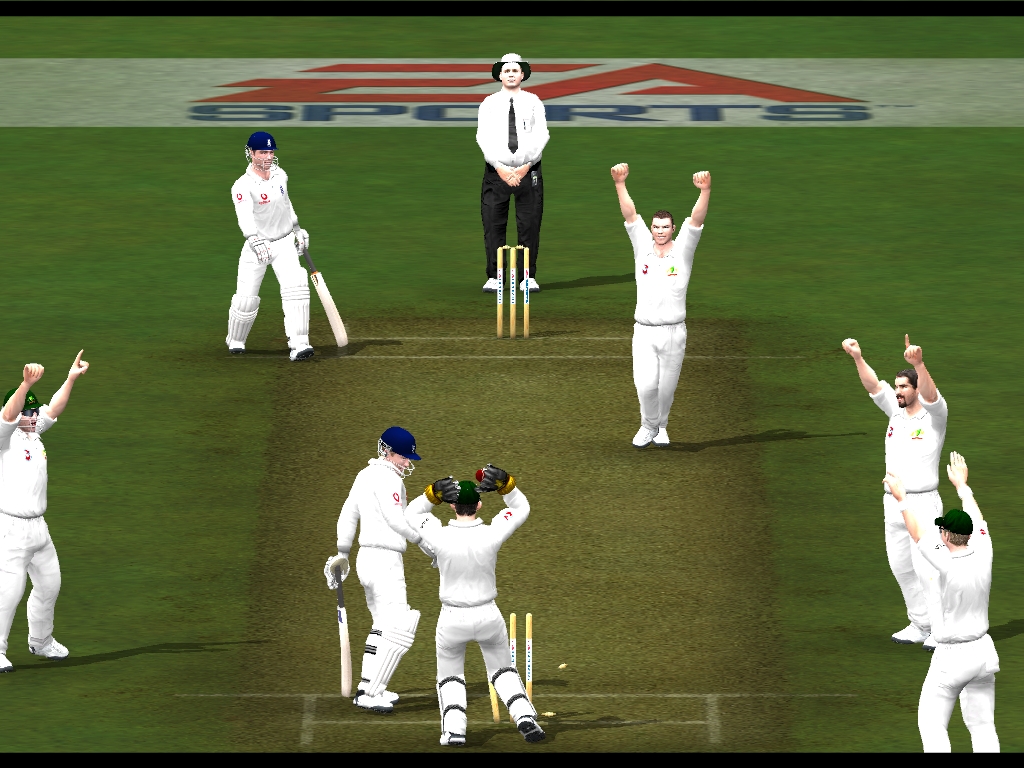
Cricket 2005
Written by: Rik
Date posted: August 4, 2013
- Genre: Sport
- Developed by: HB Studios
- Published by: Electronic Arts
- Year released: 2005
- Our score: 3
Okay, so this one comes under the “why the hell did you buy this?” banner. As for the answer, I don’t know: the chronology is a little hazy, but I’m pretty sure I’d already purchased the superior Brian Lara International Cricket 2005, and was pretty happy with it. Also, I’d already read the terrible reviews of this one, and had resolved not to ever waste my time with another half-baked cricket game. But still, there it is, in my games cupboard – all I have by way of excuse is the standard cricket game weakness: which is, in layman’s terms, the belief that a cricket game that you haven’t played yourself, despite all evidence to the contrary, might just be The Best Cricket Game Of All Time(tm).
It’s also possible that the choice of Andrew ‘Freddie’ Flintoff as the cover star for this game evoked positive memories of the Ashes 2005 series. Although this game was released before that memorable summer began, the choice of Flintoff was no doubt intended to attach the image of positive, attacking cricket to the game. As for the series itself, it arguably represented cricket at its best – an even match between bat and ball, with the momentum swinging from one side to another during each and every match, with cricket fans and non-aficionados equally enthralled by the contest as it unfolded.
Cricket 2005, on the other hand, represents cricket at its worst: stodgy and depressing, dull even to hardcore fans, and just plain baffling to the casual observer. In terms of the experience it provides, it couldn’t be more diametrically opposed to that of the 2005 series if it tried. If there is any entertainment to be found here, and it’s doubtful that there is, it certainly isn’t easy accessible to the casual player: only a hardcore fan, with his or her mind twisted by years of disappointment, could possibly wring more than a few minutes’ fun from this, and then only if he or she were willing to adhere to a strict code of grim determination that exists outside of the generally-accepted parameters of fun and enjoyment.
The fundamentals of Cricket 2005 can be traced back to Brian Lara Cricket (which itself was based heavily on Graham Gooch World Class Cricket), and thus it retains most of the same flaws. Bowling is still repetitive and boring, because there is no challenge in actually delivering the ball or putting it where you want, and so it becomes an exercise in waiting for something to happen. Because it’s incredibly easy to bowl in the same place over and over again, the computer seems to decide when wickets will fall, and they do so out of the blue without any feeling that you’ve done something to earn it other than being extremely patient.
Batting is slightly more fun, but, again, much of the tension is removed because you know where the ball is heading, and so a great deal of time is spent watching the various animations, waiting for the ball to arrive, so you can execute the shot you’ve known you were going to play for the last 20 seconds or so. Obviously, with the reflex/surprise element removed, so is much of the challenge, but don’t worry – the computer will make sure you lose wickets one way or another.
In both main areas, there have been some attempts at progress, although they’re largely unsuccessful. Bowlers technically now have a variety of deliveries at their disposal, with fast and medium-fast bowlers supposedly now able to bowl cutters and swinging deliveries. I use words like “technically” and “supposedly” because, well, good luck telling the difference between them. Even on a green pitch beneath overcast skies, conditions which the game manual (in accordance with the real-life sport) indicates should suit swing and seam bowling, the ball rarely seems to deviate significantly from the straight. (If anything, the outswinger moves in and the inswinger moves out). You also have the option of a ‘special’ delivery, such as a slower ball or a yorker, if you keep the batsman quiet for a while, but it rarely seems to be all that special in terms of taking the opposition by surprise. If you try any tactics, such as noticing a batsman hitting the ball in the air through a certain area, and then moving a fielder there, that fielder will then ignore the ball, and so the only tactic that has any effect is to just keep plugging away and wait for the batter to get out.
On the batting front, you now have the option to select a front or back foot shot, or even advance down the pitch, and when you add in the ‘six hit’ button, that, in theory, gives you a choice of 25-30 shots to play. Unfortunately, a large proportion of these are fairly useless, with some failing to ever get you any runs, others rarely resulting in contact with the ball, and a significant proportion being too dangerous to risk ever playing as nine times out of ten, they’ll get you out (and I’m not talking about the slog shots here either – it’s fairly standard strokes such as the drive, cut and hook that you need to avoid playing). Success is possible, but only once you learn the handful of shots that work and are willing to use them over and over. There’s also now an indicator which shows how ‘settled’ your batter is, which is supposed to function as follows: time spent at the crease and/or runs scored build up the meter, in turn making the execution of shots easier. In reality, you can knock around runs when the meter is low, and you can nick randomly to slip when it’s at the top. It’s another gimmick that doesn’t really work.
One area where there has been some progress, as you’d expect, is in the audio-visual department. The graphics certainly look good as static shots, less so in motion. There’s little variation between bowling actions, and they’re curiously unrepresentative, with the fast bowlers approaching the crease gingerly, as if recovering from recent surgery on a delicate area. The build of the players is uniformly rather squat and fat, which works well for, say, Shane Warne, but not for the majority of the others. Some attempt at achieving accurate likenesses has been attempted, with the usual ‘photo ironed onto a polygon’ effect, and it does mean at least that players are facially representative, even if this is somewhat undermined by their podgy physiques.
Sound-wise, things don’t seem to have moved on quite as much. Commentary is provided by Australian legends Jim Maxwell and Richie Benaud, who both sound thoroughly bored by proceedings, and it’s the usual mix of hearing “[Player Name]…to bowl” over and over again, occasionally punctuated by one of a handful of longer discussions about the state of the match. In accordance with the general bugginess of the game (more on which shortly), they often make fairly nonsensical comments (“England have played some poor cricket in this series” – we were 2-0 up!) and it’s best just to mentally tune it out. Other sounds are the usual thwacks, knocks and cheers you’d expect, although the effect that accompanies a player catching the ball has been overemphasised to the extent that it sounds like someone being slapped with a fish.
So, then, to the bugs, none of which are particularly horrendous, but they deserve a mention here as indicative of the general sloppiness that seems to afflict this game. The early signs were less than promising when I decided to use the ‘practice nets’ feature before heading into a match. The principle is quite good – there’s an meter indicating how well you time each shot, with one of the commentators also giving you guidance on shot selection. I clubbed one ball away with some success, only for Jim Maxwell to chide me for a poor shot, yet when I unsuccessfully attempted a hook and was hit in the head, he was much more appreciative, showering me with praise while my poor batsman writhed around on the floor in agony. I knew enough to ignore it, but God help a novice attempting to use this feature as intended.
Elsewhere, the wicket keeper often ignores the ball and just allows it to head to the boundary; after re-loading a save, the umpire always signals a leg-bye regardless of what happened; fielders warp around the pitch erratically, sometimes towards, sometimes away from, the ball; the short-leg fielder is like a wall, stopping the ball dead from the firmest of shots despite cowering in fear, but frequently gets criticised by the commentators for poor fielding; batsmen don’t seem to slide their bats effectively when going for a tight run and get given out when they appear in; and fielders and wicket keepers take an age to remove the bails when attempting a run-out, demolishing the stumps and appealing long after the batsman has made his ground. There are more little niggles of this nature, and, as I mentioned, none of them mean that much on their own, but put together they seem to highlight a general lack of care and attention.
If you can bear to play Cricket 2005 for any length of time, there are a number of tournaments and competitions to enter. The fact is, though, you probably won’t want to. Because I had an inkling that this game would be pretty bad, I decided to try and play through a whole test series, and write it up for an extra feature to attach to this review. The main aim was to provide some additional motivation to play for a good length of time. Having done so (you can read the results in our Cricket 2005: Ashes Diary), I can say that I afforded this game a level of scrutiny it does not deserve. It’s not all that much different from Brian Lara Cricket, but although it looks better and has more features, it’s also got more bugs, more frustrations for the experienced player, and more obstacles to enjoyment for the novice. What else is there to say? It’s another terrible cricket game, and you should avoid it regardless of your level of interest in the sport itself.

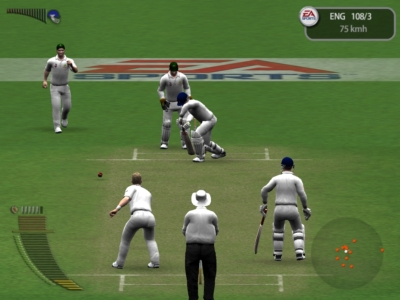
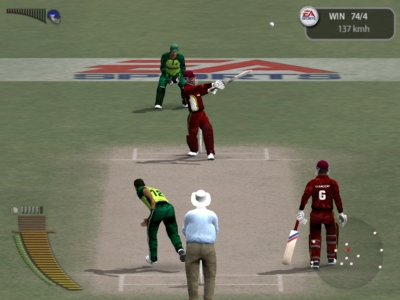
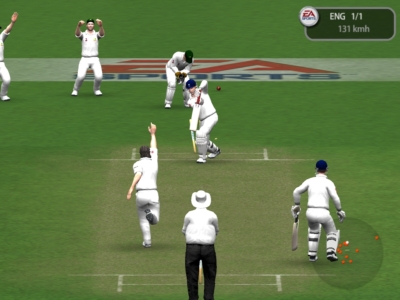
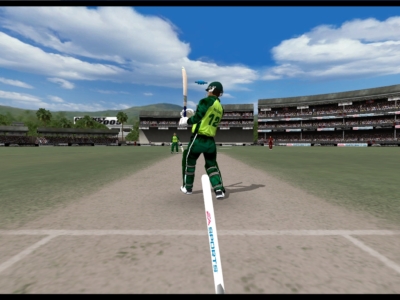
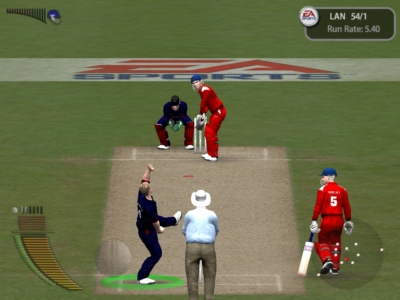

 Posts
Posts